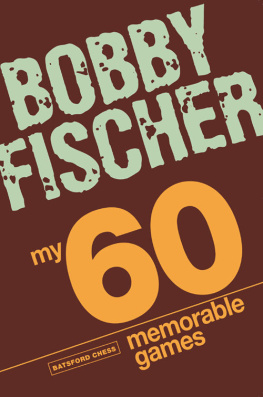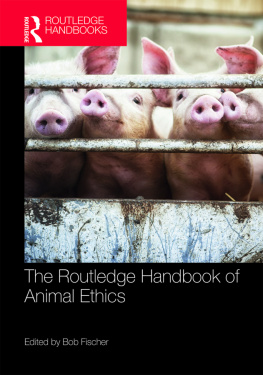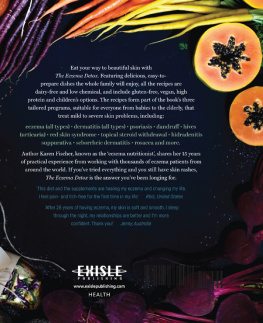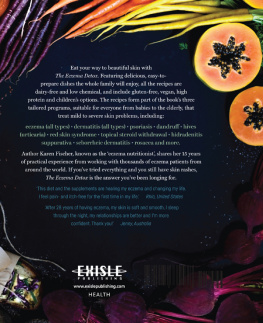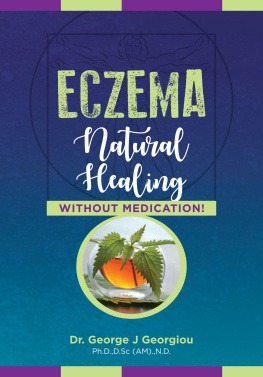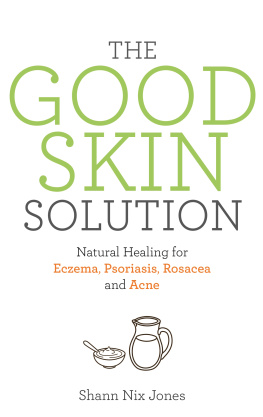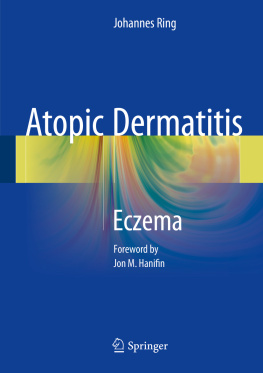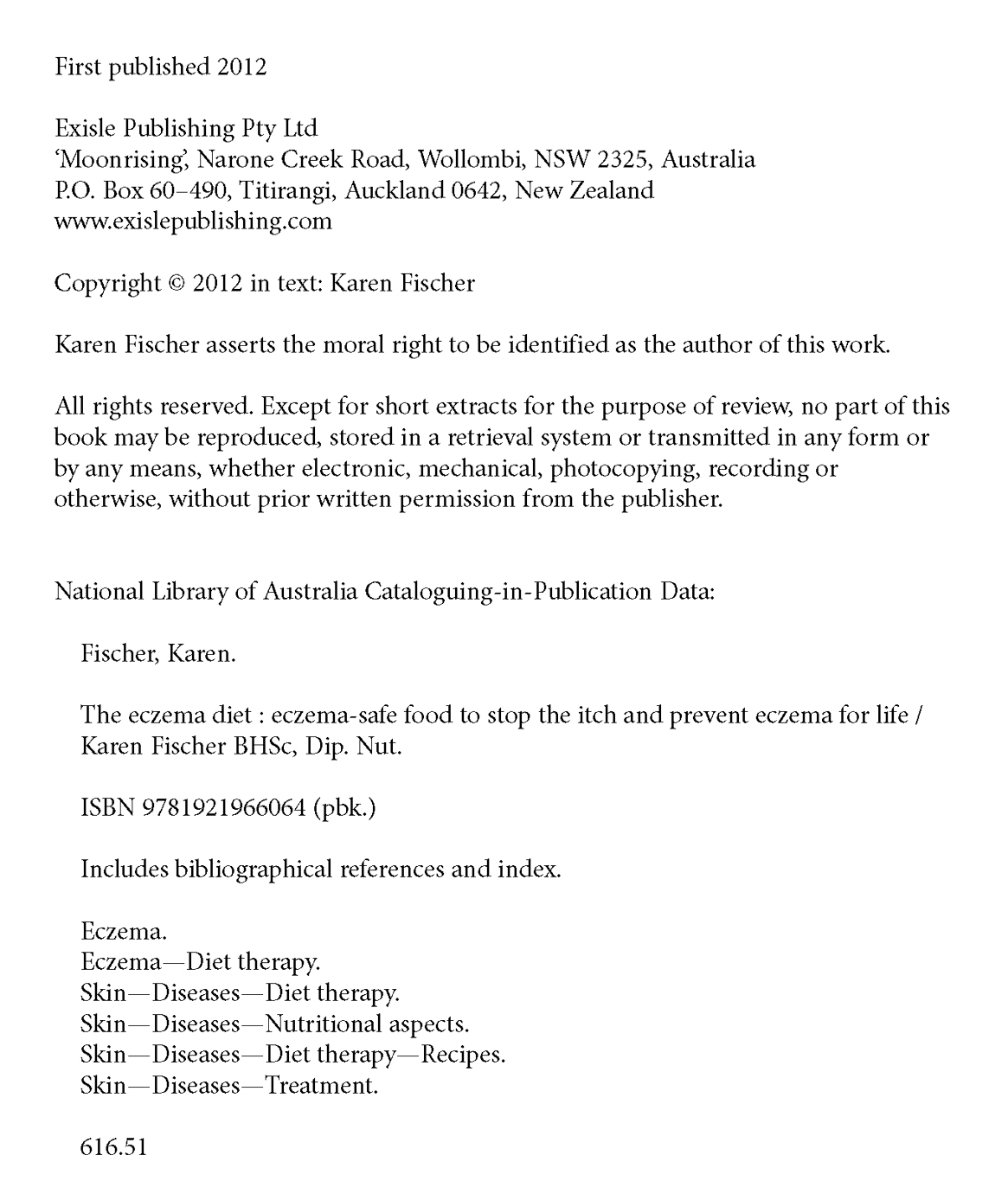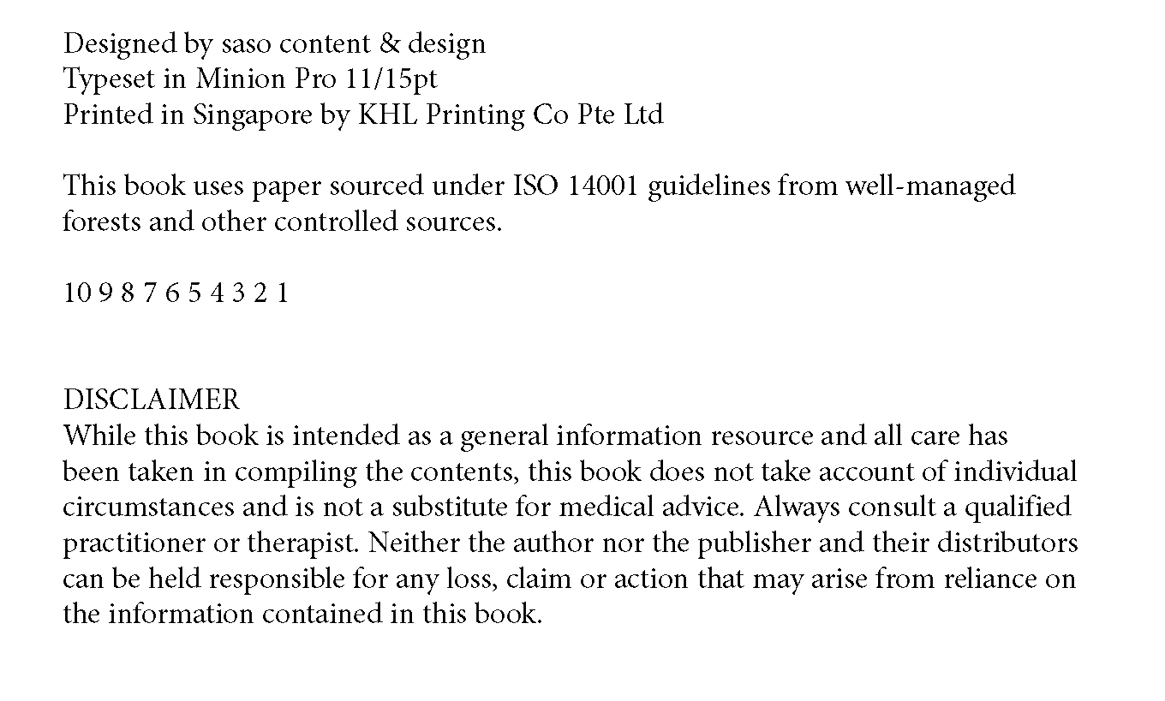KAREN FISCHER is a nutritionist and a member of the Australian Traditional-Medicine Society (ATMS). She has a Bachelor of Health Science Degree (BHSc) from the University of New England and a nutrition diploma (Dip. Nut.). In 2008, Karens bestselling book The Healthy Skin Diet won Best Health, Nutrition or Specific Diet Book at the prestigious Australian Food Media Awards. In private practice, Karens patients are almost exclusively babies, children and adults suffering with eczema. For more than a decade, Karen has used the Eczema Diet to help her patients become eczema-free. Karen is frequently a guest nutritionist on Australian television and has written health articles for Australian, New Zealand and UK publications. This is her fourth book.
The Eczema Diet is a beautifully presented and practical book that will be a valuable and powerful tool for improving the general health and the skin of millions of eczema sufferers around the world. I highly recommend it to all families with allergic and atopic conditions to improve their health and wellbeing. It uses some simple principles that highlight the importance of healthy living, food and nutrition to alter our immune system and prevent and treat allergic and immunological conditions like eczema. I am using the marvellous recipes and suggestions to improve my own familys health and skin problems, which include eczema.
Dr Gary M. Leong, MBBS, FRACP, PhD
Institute for Molecular Bioscience, the University of Queensland
Department of Paediatric Endocrinology and Diabetes, Mater Childrens Hospital
Introduction
My daughter Ayva was two weeks old when she developed spots on her face that resembled acne. The creases of her elbows and knees were red and weeping, and she would often scratch until her arms bled. When she was ten months old, a nurse from the local Early Childhood Centre, who had seen Ayva a few months earlier, exclaimed, Has your child still got eczema? I thought what a rude comment, eczema is a genetic condition and what could I do about it? I was a nutritionist and I had not considered looking at treatment options for my baby beyond cortisone cream and thick ointments.
When Ayva was one she was diagnosed with dust mite allergy, which meant she could no longer sleep with, or touch, any of her soft toys. We were advised to avoid junk food, additives and salicylates. Playing on the grass, swimming in a pool and patting the family cat inflamed Ayvas skin from head to toe so the cat was sent to grandmas house and swimming lessons were cancelled. Then one day Ayva, who was growing resentful about being different from her friends, ate some food at a friends birthday party and her eczema spread further down her legs. We noticed she was becoming more sensitive to everything and it was sad to see her suffering.
I began researching eczema. By the time Ayva was two I had devised a basic diet and supplement routine for her, and two months later, to my surprise and excitement, her eczema was gone. The temporary dietary changes were strict but soon Ayva could enjoy normal activities such as playing with fluffy toys, swimming in chlorinated pools and occasionally she could eat party food without her eczema returning, and she no longer needed topical steroids. Her diet was gradually expanded and eventually she could eat all foods without her eczema returning.
Research shows that eczema sufferers spend up to $2000 on eczema treatments each year and 36 per cent of sufferers spend more than 10 minutes each day applying topical steroids and emollients. Despite this, the number of people with eczema is rising and has tripled in recent years. Now 20 per cent of people in the developed world have eczema and its mostly babies and children who are suffering.[1]
- One in five children suffers from eczema.
- There are 1 million eczema sufferers in Australia and almost 6 million Australians will suffer from eczema at some point in their life.
- In New Zealand, more than 10 per cent of people have eczema.
- There are 5.8 million eczema sufferers in the United Kingdom, and 15 million people have eczema in the United States.
The eczema statistics may continue to rise if we do not address the main factor that determines our genetic health: our diets. According to Ordovas and Corella from the Nutrition and Genomics Laboratory, Jean Mayer U.S. Department of Agriculture: Food intake is the environmental factor to which we are all exposed permanently from conception to death. Therefore, dietary habits are the most important environmental factor modulating gene expression during ones lifespan.[2] While it is okay to use modern medicines to help you or your child gain temporary relief, a long-term solution usually involves dietary changes.
My daughter is now twelve years old and the Eczema Diet has changed a lot since I first devised this program. For the past ten years, my eczema patients have been giving feedback about the program, which enabled me to refine the Eczema Diet. One of the things I love most about my job is reading research papers on skin health. Im often in my home office until well past midnight, reading medical documents published on eczema, even ones dating back to the 1800s (a dangerous time to have eczema as doctors often prescribed toxic heavy metals which occasionally caused fatalities!). In the late 1800s, some hospital-based doctors advocated dietary changes, which were effective at eradicating eczema. By the mid 1900s, topical steroids became popular and diet research slowed during this time. However, in the last 30 years nutrition research for eczema has increased in popularity. The Eczema Diet, particularly Chapters 2, 3 and 6, presents this research in detail.
However, if you or your child are suffering and keen to get started, its fine to skip the first few chapters and begin at Chapter 4 The Eczema Diet: how it works. Then as you follow the program you can read Chapters 1 to 3 and do the handy questionnaires in Chapter 2. If you have a baby with eczema, this research and the questionnaires are still relevant to you as you can use them to analyse your family diet before conception and the dietary information becomes practical once your baby starts eating solids.
What is the Eczema Diet?
At first glance the Eczema Diet may seem like a regular elimination diet but it differs in many ways. The Eczema Diet is designed specifically for eczema sufferers. While on the Eczema Diet, you temporarily take problematic foods out of the diet and you eat nutritious eczema-safe foods that strengthen the health of your entire body. The Eczema Diet is incredibly nutritious and as your (or your childs) eczema clears up, a wider variety of foods are reintroduced to the diet so you can enjoy mostif not allfoods and remain eczema free (if you have severe allergies continue to avoid your allergy foods until given clearance by your doctor). Once the skin barrier function is restored, dust mites are no longer a problem and you can resume normal activities such as swimming and playing with pets.
The Eczema Diet is presented in three parts. Part 1 is all about your skin and is rich with tips on how to manage and mend your eczema. Part 2 has useful non-diet information that you can refer to at any time if you need a bath recipe, moisturiser advice or a quick itch-busting treatment. And Part 3 contains the eczema-safe recipes, shopping guides, food charts and menus for each specific age group, from babies to adults, as well as a party food guide for special occasions. Please keep in mind you will need to tailor this advice to suit your individual allergies, health requirements and eczema, and there is separate advice for babies, children and adults.


